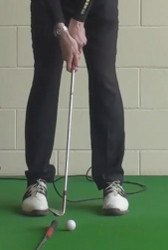
Why would you ever try to hit a wedge thin, on purpose? Sounds crazy doesn't it?
Sure, until you understand the so-called “bellied wedge” concept. You've probably seen pros use this technique; if so, you understand that it's only meant for a very specific situation.
That is, when your ball has come to rest on the outer edge of the fringe, lying against a border of taller grass or thick rough (aka the collar). While you'd prefer to putt, you risk snagging the blade on the backstroke – especially if you use a cavity-back putter. And you'd rather not take a chance on misplaying a chip shot.
That's when the bellied wedge is your best bet. It sounds advanced, but it's quite simple to execute – and most effective once you've practice a little. Here's how to play the shot:
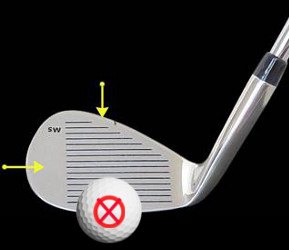
While many pros use a sand wedge for this shot, others suggest a pitching wedge because it has a straighter edge.
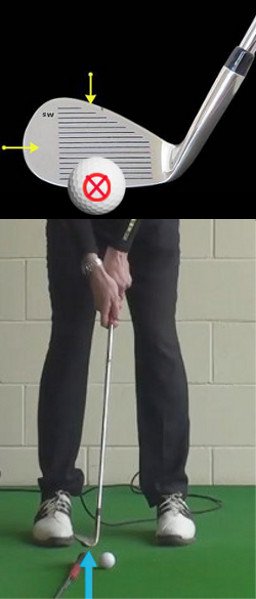
How to Play the Bellied Wedge from Fringe
You can never have enough options when it comes to the short game. Even if you are confident in your ability to hit basic chip and pitch shots from around the green, you still want to add to your collection of techniques that you can use depending on the shot at hand. Golf will throw a wide variety of situations your way during each and every round, and you need to be prepared to deal with those situations as successfully as possible. By having more than one or two options for how you can handle your short game shots, you should be able to rise to the occasion even when faced with a tricky situation.
One of the useful shots that you can benefit from adding to your short game collection is the bellied wedge from the fringe. With this shot, you are going to intentionally hit the ball with the leading edge of the club rather than the face itself. It you did it on accident, this would be known as hitting the ball 'thin' – but in this case, you are going to do it intentionally. This might seem like an odd way to handle a short shot from next to the green, but there are some important advantages that we will highlight later in the article. Sure, you probably won't find occasion to use this shot very often, but it can be incredibly handy when you do need to pull it out of the bag.
As you might imagine, this is not a shot that you can simply decide to try for the first time in the middle of a round. You need to practice this shot, as it is unlike anything else that you do on the course. Learning how the ball comes off the leading edge of the club – specifically with regard to the speed of the shot – is going to take a little bit of time and experience. You don't have to spend hours working on this shot, but hitting a few of them as part of your short game practice routine is a good idea. With practice, your confidence will naturally grow and you will soon find yourself willing to try the shot out on the course.
Shot selection is one of the underrated skills that you need to have as a golfer if you want to shoot low scores, and it is especially important in the short game. Not only do you need to have a variety of shots available to you when around the greens, you also need to know when to choose which shot, and why. As you learn how to play the bellied wedge, also pay close attention to the information provided later in this article about when this shot is an appropriate choice. Sometimes, this shot will make your life easier on the course, but that is not always going to be the case. If this shot is going to have a positive impact on your game, you need to make sure you only using it when the time is right.
All of the instruction below is based on a right handed golfer. If you are a left handed player, please take a moment to reverse the directions as necessary.
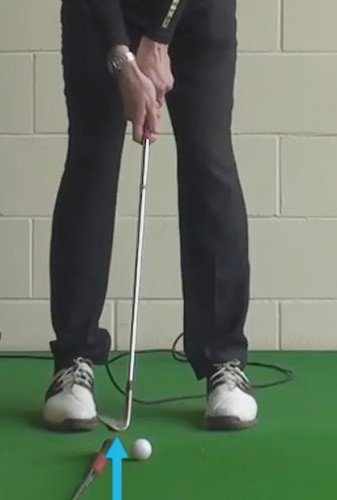
Mastering the Technique
We are going to jump right in to the technique required to play this shot successfully. Later, we will address some strategy points with this shot, including when to play it and how to best use it to your advantage. First, however, you need to understand the technique that you are going to use to pull it off consistently. The shot might look a little bit tricky at first, but it is actually quite simple from a technical standpoint. With just a bit of practice you should be able to get yourself on track with regard to the use of the bellied wedge.
The goal of a bellied wedge is to hit the ball directly on its equator using the leading edge of your club. Usually, you will want to use your most-lofted wedge for this shot, although any of your wedges should work just fine. Rather than chipping the ball up into the air as you would normally do with a wedge, you are essentially going to 'putt' the ball along the ground toward the hole. There should be very little air time – if any – on this shot. The ball is going to start to roll almost immediately, causing the shot to look more like a putt than anything else.
Although you are going to be using a lofted wedge for this shot, you are actually going to swing the club the same way you swing your putter. In fact, you are even going to use your putting grip to hold on to the club during the swing. Since the goal is to hit the middle of the back of the ball – just as you do when putting – it only makes sense to use the same motion that you use for your putting stroke.
To make the learning curve for this new shot as short as possible, consider the following tips –
- Hover the clubhead. This is one of the most important tips related to the bellied wedge shot. At address, rather than grounding the club as you most likely do for a normal chip shot, you are going to hover the club head above the ground so that the leading edge of your wedge is even with the middle of the ball. Starting out this way is the obvious choice because this is where you want the club to return to at impact. By hovering the club head behind the middle of the ball, you will already be lined up and you will simply have to rock the wedge back and through in order to hit the shot.
- Position the ball in the middle of your stance. This is another point that is intended to help you make solid contact with the shot. If you play the ball too far back, you are going to be swinging down steeply and you may hit under the ball as a result. On the other hand, playing the ball too far forward in your stance will cause you to catch it on the upswing, meaning you may hit the top half of the ball and leave the shot short of the target. Try to keep the ball right in the middle of your stance to promote a clean hit that causes the ball to roll out nicely.
- Head stability is crucial. You always want to keep your head stable and steady when hitting golf shots, but that fundamental is especially important when talking about the bellied wedge. You have to be precise with your swing to make this shot work, and precision is something that usually comes along with a stable head position. Don't allow your head to move much at all during the swing – especially not up or down – if you want to make solid contact each time you attempt this shot.
Even though it is a shot that most golfers have not tried previously, the bellied wedge is actually pretty simple to execute after just a bit of practice. Use the information contained in this section to get yourself started with this unique short game shot during your next practice session.

Looking for the Right Opportunity
Now that you should have a pretty good idea of how to hit this shot, the next step in the process is to figure out exactly when to hit it out on the course. In the title of this article, we make mention of using this shot from the fringe – so, should you deploy it every time your ball comes to rest on the fringe around the green? No, of course not. There are certain circumstances that you should be looking for which will be just right for using the bellied wedge. Consult the list below to gain an understanding of which kinds of situations are going to call for the use of this shot.
- Near the collar on the fringe. Perhaps the most-commonly found situation for using the bellied wedge is when your ball comes to rest on the fringe near the edge of the rough. When longer grass perhaps just a few inches behind your ball, you will be faced with a tricky shot. If you try to use your putter, the head of the putter could easily get caught in the grass behind the ball. If you try to chip the shot traditionally, you will have to swing in lower and could again have trouble with the rough grabbing onto the club. However, by opting for the bellied shot, you may be able to avoid any issues with the rough getting in your way. The leading edge of the wedge will cut through the grass as you swing, and you can keep the club higher in the air since you are trying to hit the ball in the middle. Many pro golfers will use the bellied wedge when faced with this situation, and you should follow their lead. Of course, you never want to try a shot on the course without first trying it in practice, so set yourself up in this situation during your next practice session and work on rolling the ball away from the collar using a bellied wedge.
- Less-than-perfect lie on the fringe. Many amateur golfers like to putt from the fringe when they have the change, as putting takes the risks associated with hitting a chip shot out of the equation. Most of the time, this is a great plan – there often isn't much difference between the fringe and the putting surface itself, so putting will allow you to knock the ball close to the hole with ease. However, if you happen to find yourself with a less-than-ideal lie on the fringe (such as when your ball is sitting down in a depression), putting won't necessarily be the best choice. Instead, try using the bellied wedge to pop the ball out of its lie. This will still be similar to a putt, but by using the wedge you will have a little better ability to overcome the rough lie without having your shot thrown off track.
- Slow greens. If your ball has come to rest on the fringe and you are playing a course that already features slow greens, using your wedge might be easier than using your putter – even if you have a great lie. The bellied wedge shot will usually transfer significant energy to the ball at impact, meaning you will be able to reach the hole without making a big swing. Instead of forcing yourself to swing hard with the putter in order to reach the target across a slow green, try using the bellied wedge and see just how easily the shot can come off.
Of course, you are not limited to just these three situations when playing a bellied wedge, but they are a good place to start. Try working on these circumstances in practice to see how well this shot works for you, and make adjustments as you go to improve your results.
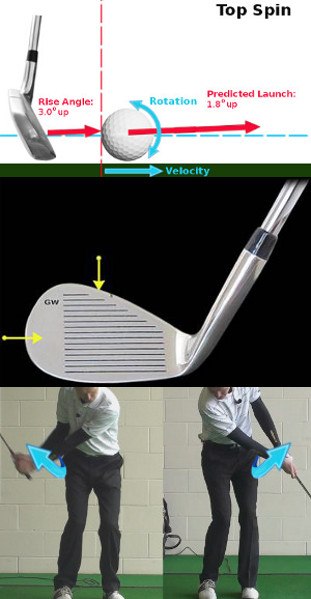
Why Not Chip?
As you have been reading through this article so far, you may have been thinking that you could just chip the ball off the fringe with your wedge rather than using the bellied style. And, of course, that is true – you could opt for a basic chip shot without having to learn the new technique involved with bellying the ball toward the hole. However, when chipping, you take on some inherent risk that just isn't present when you use the bellied wedge. Golf is all about avoiding risk whenever possible, so the bellied wedge represents a chance to steer clear of the risks that are involved with chipping.
When you hit a basic chip shot off of a tight lie (such as the fringe), you are always going to run the risk of hitting the shot either thin or fat. Even the best chipper will miss-hit the ball from time to time, and those miss-hits can be costly. For example, if you hit your chip shot fat from the fringe, the ball will likely only trickle a few feet onto the green – leaving you with a long putt. Or, if you swing through to hit a chip shot and catch the ball thin, you can easily send the ball shooting across to the other side of the green. Each of these mistakes will usually cost you one or maybe even two shots, and they will also eat away at the confidence that you have in your short game.
By choosing to belly the ball onto the green with the leading edge of a wedge, you can take the risk of those dramatic misses out of play. Sure, you can still hit a poor shot with the bellied wedge, but you will likely have more margin for error in terms of coming away with a decent result. You shouldn't ever hit this kind of shot fat, and you are trying to hit the ball thin – so that isn't a concern either. As long as you get the speed of the shot mostly correct, you should find that you have a reasonable putt for your next shot. There are never any guarantees with any kind of shot in golf, but using the bellied wedge from the fringe comes with less risk than most of your other options.
Of course, when the time comes to actually make a club choice for this type of shot, you will want to stick with the shot that gives you the most confidence as you stand over the ball. For instance, even if you have a situation that is perfect for the bellied wedge, you don't have to go in that direction if you aren't feeling confident for whatever reason. There is a lot to be said for trusting your instincts in this game, as confidence and belief are just as important as technical ability. Look at the short game shot in front of you and picture all of your different options – which one do you feel will work out the best? Most of the time, your first instinct is the right choice in this kind of situation.

Other Creative Options
As you may or may not know, the bellied wedge is only one of many unique short game shots that you can add to your collection of skills. Over the years, golfers have found a variety of ways to knock the ball close to the hole when playing from around the green, and you can benefit from the various 'inventions' that have come about through trial and error. Some of the shots listed below will work beautifully for you when put to use in your own game, while others will never quite come into form. Give each of them a try and keep the ones that seem to work out best for you.
- Hybrid bump and run. This is a similar shot to the bellied wedge, except it is played with a hybrid club off of the fringe. Again with this shot, you are going to use a putting-style stroke to swing the club back and through the ball. The shot is going to come off the face of your hybrid extremely quickly, so spend plenty of time on this shot in practice in order to dial in the distance just right. Once you learn how to control your speed, the hybrid bump and run can be a useful element in your short game arsenal.
- Toe of the putter. For a truly unique shot that you will likely only use once every few rounds (if that), you can try to pop the ball onto the green using the toe of your putter. By turning the putter down at address so that the toe is lined up with the back of the ball, you can then use a putting stroke action to knock the ball onto the green with ease. This is a shot that is most useful when you are stuck up against the collar around the edge of the green. With long grass behind your ball and no room to work, using the toe of the putter is a great way to get through the grass successfully. You certainly don't want to have to put this shot into action very often, but it has the potential to work out perfectly in just the right situation.
- Left-handed chip away from a bunker. From time to time, you might find that your ball comes to rest right up against the edge of a bunker, with no room for you to stand as a right handed golfer. When that happens, you might not have any idea of how to approach the shot. After all, if you can't stand next to the ball, there isn't much you can do to get up and down successfully. However, there is one option that is often overlooked – play the shot left handed. If you don't have anywhere to stand as a right handed golfer, you almost certainly have somewhere to stand as a lefty. Turn your wedge over so that the toe of the club is pointed down to the ground, and suddenly you will have a club that can be used with a left handed swing. This is going to be difficult to pull off, of course, so don't try to do too much – play the shot toward the center of the green and keep your head down to maximize your chance at clean contact.
Learning how to play the bellied wedge is one of many ways in which you can add to your short game versatility. It is always good to have as many options as possible at your disposal when playing short shots, as you never know what kind of terrain will be between you and the hole. Work on mastering this shot in practice and be ready to put it into action when the right opportunity arises!






